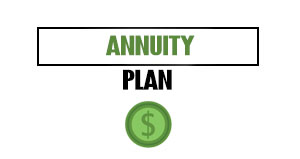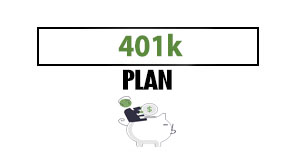Instead, companies are moving to defined-contribution plans. The employer promises to pay a set amount into the employees’ pension funds, but they make no guarantee regarding the payout. The company’s obligation ends when they’ve made the payments, so the employee’s risk moves.
If the retirement fund performs poorly, their pensions will be lower than they might expect. The company doesn’t have to make up the difference.
Defined-contribution plans still deliver a tax benefit. The retirement fund takes pre-tax dollars and lets them grow on a tax-deferred basis, without capital gains tax. The fund also takes contributions from both employer and employee.
With defined-contributions, usually, the employer matches the employee’s contributions indirectly. For every dollar, the employee pays into their retirement fund; for example, the employer might contribute fifty cents.
A few lucky employees might even get a 1:1 contribution ratio, up to a certain percentage of the employee’s contribution or dollar amount. Although a dollar to dollar contribution for these plans is often limited to about 5 percent of an employee’s salary — the government allows 18 percent of the employee’s salary to be invested in the plan, tax-deferred each fiscal year.
Defined-Contribution Plans Are Unpredictable
The disadvantage of defined-contribution plans isn’t limited to the lack of guaranteed payouts. Because companies are on the hook if a defined-benefit pension fails to perform well enough to meet its payment obligations, they control the investments.
Employees can relax. They don’t have to assess portfolios or worry about management fees — these are all taken care of from the funds’ management company. The employee can look forward to a retirement on an income that they know that can expect.
For employees on a defined-contribution plan, though, life is more complex. Employees have more control over their retirement plans. They have more freedom to choose portfolios and select the assets they want to own.
For employees who are savvy investors, that control might be an advantage. But most employees aren’t knowledgeable about investment strategies. They don’t know how to compare portfolios or diversify their holdings.
These employees often buy too much of their own company’s stock, a choice that shows admirable loyalty but which makes their holdings unstable.
Defined-Contributions are riskier for employees, but they are now the kind of retirement plan that most employees can expect to receive. Many of the employees now receiving defined-benefit plans are those in the public sector. If the market falls or the pension fund fails to earn enough to pay the benefits promised, and it’s taxpayers who will have to make up the difference.
Hybrid plans.
More recently, there are newer variations of pension plans for you to consider. These hybrid plans include SEPs (Simplified Employee Pension Plans).
Designed for the self-employed and small business owners, “the money you invest is pre-tax. If you want to set this up, you fill out an IRS form 5305-SEPSimplified Employee Pension-Individual Retirement Account Contribution Agreement,” explains Kayla Sloan in a previous Due article.
“Setting up a SEP IRA can be done just before you file your taxes,” adds Kayla. “This allows you to adjust your contribution if your taxes are high that year.” If you set up your plan correctly, you “lower what you would owe Uncle Sam.”
“A drawback, unfortunately, is that the largest amount the IRS will allow you to contribute is $54,000,” Kayla states. “Additionally, if you employ others, you must set up SEP IRAs for them also under certain conditions.
To ensure you set the funds up properly, go over the requirements thoroughly before you decide to invest in this manner.”
Another twist on the traditional pension plan is the cash balance plan. Similar to a defined benefit plan, it also contains elements that resemble a 401(k). A 402 (k) also guarantees access to a certain sum upon reaching retirement using the following formula:
annual benefit = (wage x pay credit rate) + (account balance x interest credit rate).
When you retire, you then have the option to either take the entire lump sum in one shot or an annuity that will make regular payments. This option means that the funds more portable. What’s more, they’re federally insured through the Pension Benefit Guaranty Corporation.
Vesting and withdrawal.
“Pension plans require employees to be vested in the company, typically three to five years,” explain the folks at MoneyTips. “The vesting schedule may be a cliff (0% until a certain employment period is reached, then 100 percent) or a graded scale (for example, 20 percent vested after three years employment, and 20 percent per additional year of work until the employee is 100 percent vested).”
What if you leave the company before retirement?
If you leave the company before retirement, the “amount of pension depends on a combination of the vesting schedule and length of employment. You’ll have to apply for your benefits when you reach retirement age.”
In most cases, you can start collecting your pension set at the retirement age of 65 years.
However, early withdrawals can occur as early as age 55. The catch with the withdrawal of funds is that there will be reduced funds and potentially tax headaches. “Withdrawals from a Defined Contribution plan, such as a 401(k), are relatively simple and are made at the discretion of the employee, once retirement age is reached,” adds the MoneyTips team.
Usually, payouts from a Defined Benefit come in two forms.
- What is a pension plan?
- How does a Pension Plan Work?
- How a pension works
- The Move to Defined-Contributions
- Annuity
- Are pensions taxable?
- The Difference Between a Pension and a 401(k)
- The History of the Pension Plan
- The Link Between Your Pension and Your Job
- How to Find Old 401(k) and Pension Accounts
- Vesting Your Pension Funds
- It’s SEP to You
- Do You Really Need a Pension?
- How Much Should You Contribute to Your Pension Plan?
- How Much are You Allowed to Contribute a Pension Plan?
- Where’s My Money?
- Calculating the Value of Your Retirement Fund
- Common Causes of Errors in Pension Calculation
- Can I Tap My Pension Plan Early?
- Monthly Annuity or Lump Sum?
- Are There Any Risks Involved With Pensions?
- What Happens With My Pension When I Retire?
- What Happens to Your Pension if You Die?
- Can You Have a Pension and 401(k) and IRA?
- Final Retirement Tips




